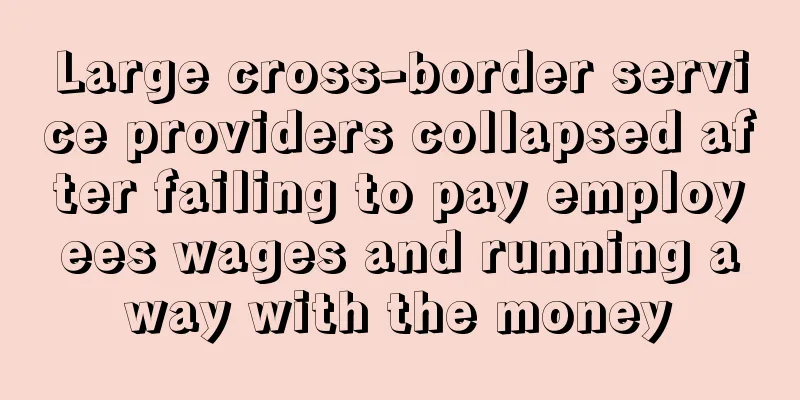A cross-border seller wanted to go public last year, but laid off employees this year!

|
There are still opportunities to enter the cross-border e-commerce market now, but the threshold is higher.
In 2022, cross-border e-commerce was called the worst year by many industry insiders. With declining traffic and low prices, cross-border sellers are trembling to survive. In the cross-border circle, all fields are involved, and as the days of cross-border sellers become difficult, the domino effect emerges, and the business of cross-border e-commerce platforms such as Amazon, freight forwarding, collection, trademarks, trading accounts, training and other service providers also declines.
Why did the cross-border e-commerce industry, which was in a very good situation in the past two years, take a sharp turn for the worse in 2022? The most common explanation is that the dividends from the epidemic have disappeared. At the same time, since the beginning of this year, developed regions such as the United States and Europe have ushered in ultra-high inflation levels, consumer demand has cooled across the board, and an inventory crisis has erupted. Overseas markets have not had time to digest excess goods, so the consumption boom around 2020 is naturally "no longer there."
The "deterioration" of the overall environment has indeed caused a large number of cross-border sellers to see a significant year-on-year decline in traffic and profits. Many sellers even bluntly stated that they are "losing money every month" and are about to go out of business.
Among these negative emotions, if we observe carefully, we will find that many cross-border sellers who are "having a hard time" are really struggling and are currently in the stage of "clearing out inventory and leaving". However, there is another group whose business is not as bad as they say, and what they think of as losses is actually like this:
Last year, we made 50 million, but this year, we have only made 5 million. It’s a huge loss…
The editor believes that this situation is not so much a loss as it is that sellers are not making as much money as before, and we cannot deny the development prospects of cross-border e-commerce because of this. Judging from the export data, cross-border e-commerce is still booming. Customs data show that in July, China's exports increased by 23.9% year-on-year in RMB terms, the highest monthly year-on-year growth rate since March 2021; in July, China's exports increased by 18% year-on-year in US dollars.
However, we have to admit that the law of the jungle and survival of the fittest, the 80/20 rule also applies to the cross-border circle. With the transformation and upgrading of the cross-border e-commerce market, the competition in this "fertile land" for making money will only become more intense. Both sellers and service providers have to find their own way to survive in the ever-changing market.
Cross-border sellers are on a roller coaster ride: going public last year, laying off employees this year
Every year, there are sellers who withdraw from cross-border e-commerce, and every year there are voices like "This year is the most difficult year". This year is no exception, and it seems that the voices of misery are even louder.
" Many sellers are trying to recover their funds. To be honest, among the people I've come into contact with, no one says they are doing well right now . " Especially on the Amazon platform, which is more focused on Chinese sellers, Amazon people feel more deeply that the entire industry is indeed not as optimistic as before.
"It's more difficult to do business on Amazon this year. After learning about the situation of my peers, I found that the main task in the first half of the year was to clear inventory. Profits are basically supported by old links, and new products are difficult to promote. " A seller on the European site said that the price involution problem is even worse this year. Last year, the average customer unit price in his category was still above 200 euros, but now it is basically below 80 euros.
There are also feedbacks from sellers on the European site that under the impact of exchange rates, even though the price per customer of the product is not much different, the RMB amount of 1,000 orders this year and 1,000 orders in the past is 10% different, and the profit and commission have been halved. Overseas demand is still there, but purchasing power has declined. Even if the old links are still selling orders, the conversion rate has obviously dropped. Gifts cannot effectively increase the number of orders, and direct price cuts are needed to effectively stimulate transactions.
Similar examples abound.
"The entire category is very competitive. When competitors cut prices for promotions, they don't just cut prices slightly, but significantly. Small and medium-sized sellers are engaging in price wars, and so are top sellers. Products that used to sell for $25-30 are now all sold for $15-20. Products that used to sell for around $15 are now selling for $9.99 or even $7.99. Although prices have dropped, Amazon's shipping costs and inflation fuel surcharges have increased by 15%. Add to that advertising fees, storage fees and other costs, and we dare not consider air freight, red-ticket shipping and other logistics methods when shipping to Amazon warehouses. Even if we ship by sea, we have to consider whether the profit is enough."
The editor learned that one seller’s order volume has decreased by 70% this year, and the selling price on Amazon has also dropped from US$59 to US$39. In this case, even without any advertising promotion, each product will lose at least US$3. However, he did not give up this product because the store has expanded its product line and is now using this product to attract traffic to the store. This method is not only cheaper than fake orders, but it can also "drag down competitors" by the way.
In addition to the sellers, the prices of many products on Amazon's own sales platforms are so low that you will doubt your life. Some products even have no profit or require the platform to subsidize them.
In this context, Amazon sellers are not making money anymore, and more people are changing their careers. The jokes are also updated:
Amazon ’s latest strategy for 2022: market research – determine the product – find a factory to place an order – prepare copywriting, pictures, A+ – ship – slack off for a week – put the product on the shelf, prepare to advertise – automatic plus manual – conversion is very poor – clear the stock – abandon – buy an electric bike – register a rider – finally, finally pay off the payment…
There are also some sellers who have not yet reached the point of changing careers, but their living conditions have also changed dramatically. "We have a major customer who vowed to go public last year, but this year he is laying off employees," said a factory manager.
Some factories only work three days a week, and freight forwarders, VAT and other service providers are under pressure
It is understood that many factories mainly supply goods to cross-border e-commerce sellers. When the situation was very good in the past two years, cross-border sellers naturally wanted to take advantage of the situation, sell more goods and make more money, so they asked the cooperating factories to increase production capacity. Many factories followed the "trend" and expanded their workshops and manpower.
The fate of cross-border sellers and factories are closely related. When sellers are having a hard time and cannot pay to pick up the goods, the goods in the factory become "hot potatoes" or even a "time bomb" that drags down the factory.
"One of my major clients is engaged in cross-border e-commerce . Even though the sales of this major client were affected by the sky-high freight rates in the past few years, the sales volume has been very stable . Therefore, the money earned from supplying goods in the first half of each year is enough to pay for costs such as rent and labor expenses, and the second half of the year is basically pure profit. This year , the sales volume of this major client has dropped sharply , and due to the domestic epidemic, our factory has basically been on holiday in the first half of the year. " A factory director said that so far this year, not a single cabinet has been shipped out, let alone making money, and breaking even is already out of reach.
It is understood that the current situation of factories taking extra-long holidays is not an isolated case. Although many factories have not yet closed down, layoffs are inevitable. The few remaining employees only need to work two or three days a week, which can be said to have achieved "holiday freedom."
In addition to factories, freight forwarders, VAT, registered trademarks and other service providers are also complaining.
"I thought the cost price I paid was already very low, but who knew that my peers were paying at a loss." A freight forwarder said that the market involution will be even more severe in 2022. He has witnessed many small freight forwarding companies around him go bankrupt. The peak season in the second half of previous years has arrived early, but there has not been a splash so far this year. Freight forwarders who entered this industry in 2022 without a customer base will find it difficult to develop new customers because they have no support from old customers. After deducting rent and other living expenses from their wages, they are basically empty-handed every month.
Among the various service providers that rely on cross-border sellers, such as ERP software service providers, account service providers, trademark service providers, and VAT service providers, the word most mentioned this year is "volume."
"Since the beginning of this year, the company's new customer growth rate has been only 1%, which is much lower than in the previous two years," said an employee of a well-known service provider in the industry. The interests of sellers and service providers are tied together. Sellers will open new stores only if they sell well, and then their VAT, trademark and other service businesses will be easier to do. However, sellers are not selling well now, and their opportunities to develop new businesses are greatly reduced. However, competition among peers is very fierce. Apart from cutting prices to grab business, they have no other choice.
Even cross-border e-commerce platforms such as Amazon have fallen into the dilemma of declining performance.
Amazon's second quarter financial report shows that Amazon's online retail sales have fallen for the second consecutive quarter, down 4.3% to $50.9 billion in the second quarter. To this end, Amazon had to make up for the decline in its online sales by charging Prime members and third-party sellers. In the second quarter, Amazon's seller service revenue increased by 9.1% to $27.4 billion, and advertising sales increased by 17.5% to $8.8 billion.
Wish, a cross-border e-commerce platform that has been losing money continuously , is still "running" on the road of losses. Data shows that in the second quarter of this year , Wish's revenue was US$134 million and its net loss was US$90 million, a year-on-year reduction of 19%; the adjusted EBITDA was a loss of US$58 million, a year-on-year reduction of 13%. More importantly, Wish's monthly active users in the second quarter were only 23 million, a year-on-year decrease of about 74%.
Independent websites cannot escape the plight of weak growth. Shopify, the leading independent website building tool, has announced a 10% layoff of its employees. It is reported that Shopify only added 71,000 merchants in the first half of this year, but added 680,000 people during the peak of the epidemic in 2020. Even last year, when the epidemic bonus was fading, the number of new merchants reached 314,000.
U.S. e-commerce prices fall for first time in more than two years
As inflation in the United States remains high, American consumers are spending more on daily necessities and have to cut spending on other products. The clothing category has become unsalable.
To this end, Walmart.com is reducing inventory through price cuts and promotions. It is reported that some clothing products can be discounted up to 60%.
In addition to Walmart, Target has also previously boosted sales in multiple categories such as clothing and electronics by lowering product prices.
The survival environment of cross-border e-commerce has changed, and one of the important reasons is the disappearance of the epidemic dividend.
According to the Adobe Digital Price Index, as demand for consumer goods cools during the pandemic, shaken consumer confidence and falling spending, coupled with oversupply at some retailers, are driving down prices in major online categories such as electronics and apparel. However, prices of "essential products" such as food are accelerating, rising by a record 13.4% compared with the same period last year , the largest increase among all categories.
The forecast indicates that retail cargo entering U.S. ports will decrease in the second half of the year due to slower economic growth caused by consecutive interest rate hikes and persistent inflation .
The National Retail Federation said total retail cargo arriving at the largest U.S. ports from July to December likely reached 12.8 million 20-foot equivalent units, down 1.5% from the same period last year.
The economy is slowing , and NRF expects U.S. goods imports to fall in 2022, with a potentially larger drop in 2023 .
The global e-commerce environment can be seen from the current market situation in the United States.
Rational thinking: Has the bonus period of cross-border e-commerce passed?
In the field of cross-border e-commerce, no matter what period it is, there will always be a situation where " outsiders want to come in, old players want to leave " . This year, there are more sellers who want to exit and do not understand why newcomers want to enter the market at this time, which is actually understandable.
Perhaps the "wealth-making myth" of cross-border e-commerce in the past two years was too attractive, which drove more people to enter the market. Consumers are no longer enthusiastic about shopping, and there are more sellers fighting in the limited gold-digging stage. There will inevitably be more cross-border sellers than before who will not be able to benefit from the epidemic dividends. Now is the time for them to exit.
We have to admit that this massive elimination war in cross-border e-commerce is not only driven by the disappearance of the bonus period of the epidemic, but also by people's misjudgment of the situation.
In the past two years, cross-border sellers' orders have soared, mainly due to the shutdown of foreign countries and the interruption of supply in consumer countries. Chinese sellers with strong supply chain advantages have sufficient production capacity and temporarily won the order share of offline and other sellers. Whether this luck can continue depends on the subsequent development of the epidemic. The law of development of things is always that water overflows when it is full and the moon wanes when it is full. If cross-border sellers who have tasted the sweetness want to take advantage of the victory to expand the scale of sales, they must bear greater risks behind it.
Obviously, many sellers took advantage of the situation with the mentality of taking a gamble and pursued their victory. The higher they stood, the harder they fell. The elimination survival competitions that used to take place every year became more frequent and more brutal. Their past experiences also brought a certain "psychological shadow" to their peers, causing panic. Statements such as "the bonus period of cross-border e-commerce has passed" and "entering the cross-border e-commerce market now is a dead end" were widely circulated.
In fact, cross-border e-commerce is far from being out of reach.
" This year is not that difficult. Our sales have increased significantly compared to last year . I expect the overall performance in the second half of the year to be better than the same period last year. Survivor bias will occur at any time . When things are good , we only see sellers who make a lot of money , and when things are bad , we only see miserable sellers. If we look at the overall environment rationally and comprehensively , our mentality will be much more stable ." The editor communicated with a cross-border seller and found that their company's store sales caught up with last year's peak season, with sales on the Japanese site increasing fivefold and on the European site increasing sevenfold.
The benefits of cross-border e-commerce are still there, but it does place higher demands on cross-border sellers.
Many sellers can relate to this. "In the past, we could make money as soon as the product was put on the shelves. Now it is not as easy as before to launch new products . Companies need to spend more energy on developing new products, and also take into account the design and quality . The requirements are indeed higher. " Cross-border e-commerce has higher and higher requirements for product selection , operation , and supply chain capabilities. So in general , it is definitely not as easy as in the past few years. The categories are slowly becoming saturated . This is a normal development law of the industry. Sellers in the game cannot change the overall environment, but they can change themselves and try to adapt to the overall environment.
Therefore, cross-border e-commerce still holds unlimited opportunities for those who are qualified and well prepared!
You could make 50 million last year, but only 5 million this year, so you lost money?
“Last year, a cross-border e-commerce boss could have earned 50 million yuan, easily bought a house in Shenzhen Bay, and easily used the money to buy a Porsche Panamera. But this year he can only earn 5 million yuan. In comparison, he lost a lot of money.” An industry insider said that although the living environment of cross-border e-commerce has changed and the threshold for cross-border e-commerce has become higher, related practitioners still have money to make, but they just make less money. Many bosses say they have suffered losses because their definition of losses is not the same as what you think.
Of course, there are also many sellers who say that although they have not lost money, they can't see where the money is! The money earned from selling goods will never warm up, and you may have to use the money to continue to buy and sell goods in the next second... However, don't say that cross-border e-commerce can't make money because of this. When you decide not to do it one day, you will find that you have quietly accumulated a lot of money. It is said that a seller worked hard every day in cross-border e-commerce, wearing 2 T-shirts back and forth, exhausted, and decided to stop doing it after the store had problems . After receiving the payment, he immediately bought a car and a house ...
Some cross-border sellers complain about "no money, hard work" one second, but the next second, they continue to devote themselves to the great cause of building cross-border e-commerce. How could they do so if it were not profitable? This has also driven the growth of China's import and export data.
According to data released by the General Administration of Customs on August 7, in the first seven months of this year, China's total import and export value reached 23.6 trillion yuan, a year-on-year increase of 10.4%, achieving a rapid double-digit growth. Among them, imports and exports in July increased by 16.6% year-on-year, maintaining the trend of continued recovery in foreign trade growth since May, making a positive contribution to stabilizing the macroeconomic situation.
Customs data showed that in July, China's exports increased by 23.9% year-on-year in RMB terms , the highest month-on-month year-on-year growth rate since March 2021; in July, China's exports increased by 18% year-on-year in US dollar terms.
From the perspective of export structure, in the first seven months, China's exports to major trading partners such as ASEAN, EU, the United States and South Korea all achieved double-digit year-on-year growth, with exports to ASEAN and EU increasing by 19.1% and 19.7% respectively; exports to countries along the Belt and Road increased by 19.8% year-on-year. During the same period, exports from private enterprises increased by 20.9% year-on-year, higher than the overall year-on-year growth rate of 14.7% during the same period; exports of mechanical and electrical products and labor-intensive products both achieved year-on-year growth, with automobile exports increasing by 54.4% year-on-year.
Looking ahead to the third quarter, China's exports are expected to maintain a high growth rate ! Cross-border e-commerce is still possible!
|
>>: $47 wedding dress becomes popular in the United States, SHEIN is "out of the circle" again
Recommend
Application for coupons for Japan Asia’s September limited-time sale is now open!
This limited-time promotion will be held from Sep...
What is taxomate? taxomate Review, Features
Taxomate is an eCommerce accounting integration s...
What is Yuju? Yuju Review, Features
Yuju helps companies increase sales through the b...
TikTok once again won the global download volume crown in February and has the highest global revenue for 11 consecutive months!
According to data from mobile application data an...
Total U.S. imports to grow 20% in 2021, with major changes in many categories
Jungle Scout recently released the 2021 U.S. Glob...
Shopify will release its second quarter financial report, and its performance may exceed expectations
Canadian e-commerce giant Shopify will release it...
What is Atome Financial? Atome Financial Review, Features
Atome Financial is a Singapore-based consumer ins...
During the holiday shopping season, e-commerce faces challenges such as supply chain and returns
According to an ACG Global survey, 41% of retaile...
Visa study shows: Malaysians will continue shopping in the “new normal” after the epidemic
After the outbreak, Malaysia implemented lockdown...
What is Paravel? Paravel Review, Features
Paravel is a sustainable travel brand dedicated t...
Loss of 3 million overnight! The factory faces many difficulties in transforming to become Amazon
A foreign trade factory owner who owns 8 properti...
Wig giant Rebecca's annual revenue was 1.33 billion, and its net profit fell by more than 80%!
Under the influence of the epidemic, wig sales ha...
What is tanfyyoungfashionshop? tanfyyoungfashionshop Review, Features
tanfyyoungfashionshop is a retail website focusing...
Shipping costs have stopped falling and rebounded. Will US ports be congested again?
Since the beginning of the year, shipping costs h...
With explosive orders and fines, where will Temu semi-custodial sellers go?
Unlike the previous full-hosting model, the advan...









